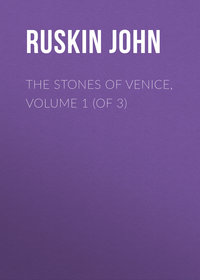 полная версия
полная версияThe Harbours of England
IX.—SIDMOUTH
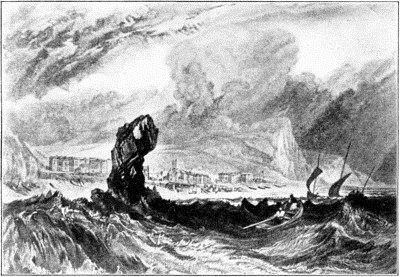
This drawing has always been interesting to me among Turner's sea pieces, on account of the noble gathering together of the great wave on the left,—the back of a breaker, just heaving itself up, and provoking itself into passion, before its leap and roar against the beach. But the enjoyment of these designs is much interfered with by their monotony: it is seriously to be regretted that in all but one the view is taken from the sea; for the spectator is necessarily tired by the perpetual rush and sparkle of water, and ceases to be impressed by it. It would be felt, if this plate were seen alone, that there are few marine paintings in which the weight and heaping of the sea are given so faithfully.
For the rest it is perhaps more to be regretted that we are kept to our sea-level at Sidmouth than at any other of the localities illustrated. What claim the pretty little village has to be considered as a port of England, I know not; but if it was to be so ranked, a far more interesting study of it might have been made from the heights above the town, whence the ranges of dark-red sandstone cliffs stretching to the southwest are singularly bold and varied. The detached fragment of sandstone which forms the principal object in Turner's view has long ago fallen, and even while it stood could hardly have been worth the honor of so careful illustration.
X.—WHITBY
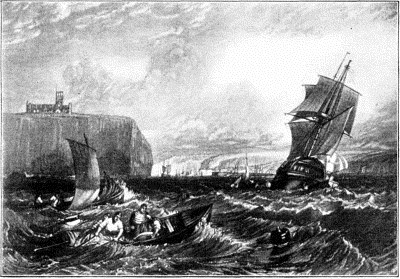
As an expression of the general spirit of English coast scenery, this plate must be considered the principal one of the series. Like all the rest, it is a little too grand for its subject; but the exaggerations of space and size are more allowable here than in the others, as partly necessary to convey the feeling of danger conquered by activity and commerce, which characterizes all our northerly Eastern coast. There are cliffs more terrible, and winds more wild, on other shores; but nowhere else do so many white sails lean against the bleak wind, and glide across the cliff shadows. Nor do I know many other memorials of monastic life so striking as the abbey on that dark headland. We are apt in our journeys through lowland England, to watch with some secret contempt the general pleasantness of the vales in which our abbeys were founded, without taking any pains to inquire into the particular circumstances which directed or compelled the choice of the monks, and without reflecting that, if the choice were a selfish one, the selfishness is that of the English lowlander turning monk, not that of monachism; since, if we examine the sites of the Swiss monasteries and convents, we shall always find the snow lying round them in July; and it must have been cold meditating in these cloisters of St. Hilda's when the winter wind set from the east. It is long since I was at Whitby, and I am not sure whether Turner is right in giving so monotonous and severe verticality to the cliff above which the abbey stands; but I believe it must have some steep places about it, since the tradition which, in nearly all parts of the island where fossil ammonites are found, is sure to be current respecting them, takes quite an original form at Whitby, owing to the steepness of this rock. In general, the saint of the locality has simply turned all the serpents to stone; but at Whitby, St. Hilda drove them over the cliff, and the serpents, before being petrified, had all their heads broken off by the fall!
XI.—DEAL
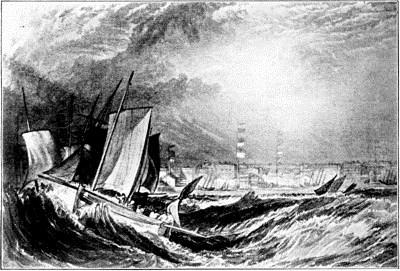
I have had occasion,23 elsewhere, to consider at some length, the peculiar love of the English for neatness and minuteness: but I have only considered, without accounting for, or coming to any conclusion about it; and, the more I think of it, the more it puzzles me to understand what there can be in our great national mind which delights to such an extent in brass plates, red bricks, square curbstones, and fresh green paint, all on the tiniest possible scale. The other day I was dining in a respectable English "Inn and Posting-house," not ten miles from London, and, measuring the room after dinner, I found it exactly twice and a quarter the height of my umbrella. It was a highly comfortable room, and associated, in the proper English manner, with outdoor sports and pastimes, by a portrait of Jack Hall, fisherman of Eton, and of Mr. C. Davis on his favorite mare; but why all this hunting and fishing enthusiasm should like to reduce itself, at home, into twice and a quarter the height of an umbrella, I could not in any wise then, nor have I at any other time been able to ascertain.
Perhaps the town of Deal involves as much of this question in its aspect and reputation, as any other place in Her Majesty's dominions: or at least it seemed so to me, coming to it as I did, after having been accustomed to the boat-life at Venice, where the heavy craft, massy in build and massy in sail, and disorderly in aquatic economy, reach with their mast-vanes only to the first stories of the huge marble palaces they anchor among. It was very strange to me, after this, knowing that whatever was brave and strong in the English sailor was concentrated in our Deal boatmen, to walk along that trim strip of conventional beach, which the sea itself seems to wash in a methodical manner, one shingle-step at a time; and by its thin toy-like boats, each with its head to sea, at regular intervals, looking like things that one would give a clever boy to play with in a pond, when first he got past petticoats; and the row of lath cots behind, all tidiness and telegraph, looking as if the whole business of the human race on earth was to know what o'clock it was, and when it would be high water,—only some slight weakness in favor of grog being indicated here and there by a hospitable-looking open door, a gay bow-window, and a sign intimating that it is a sailor's duty to be not only accurate, but "jolly."
Turner was always fond of this neat, courageous, benevolent, merry, methodical Deal. He painted it very early, in the Southern Coast series, insisting on one of the tavern windows as the principal subject, with a flash of forked lightning streaming beyond it out at sea like a narrow flag. He has the same association in his mind in the present plate; disorder and distress among the ships on the left, with the boat going out to help them; and the precision of the little town stretching in sunshine along the beach.
XII.—SCARBOROUGH
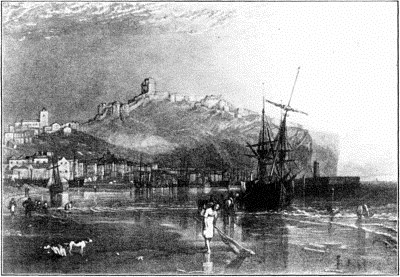
I have put this plate last in the series, thinking that the reader will be glad to rest in its morning quietness, after so much tossing among the troubled foam. I said in the course of the introduction, that nothing is so perfectly calm as Turner's calmness; and I know very few better examples of this calmness than the plate before us, uniting, as it does, the glittering of the morning clouds, and trembling of the sea, with an infinitude of peace in both. There are one or two points of interest in the artifices by which the intense effect of calm is produced. Much is owing, in the first place, to the amount of absolute gloom obtained by the local blackness of the boats on the beach; like a piece of the midnight left unbroken by the dawn. But more is owing to the treatment of the distant harbor mouth. In general, throughout nature, Reflection and Repetition are peaceful things; that is to say, the image of any object, seen in calm water, gives us an impression of quietness, not merely because we know the water must be quiet in order to be reflective; but because the fact of the repetition of this form is lulling to us in its monotony, and associated more or less with an idea of quiet succession, or reproduction, in events or things throughout nature:—that one day should be like another day, one town the image of another town, or one history the repetition of another history, being more or less results of quietness, while dissimilarity and non-succession are also, more or less, results of interference and disquietude. And thus, though an echo actually increases the quantity of sound heard, its repetition of the notes or syllables of sound, gives an idea of calmness attainable in no other way; hence the feeling of calm given to a landscape by the notes of the cuckoo. Understanding this, observe the anxious doubling of every object by a visible echo or shadow throughout this picture. The grandest feature of it is the steep distant cliff; and therefore the dualism is more marked here than elsewhere; the two promontories or cliffs, and two piers below them, being arranged so that the one looks almost like the shadow of the other, cast irregularly on mist. In all probability, the more distant pier would in reality, unless it is very greatly higher than the near one, have been lowered by perspective so as not to continue in the same longitudinal line at the top,—but Turner will not have it so; he reduces them to exactly the same level, so that the one looks like the phantom of the other; and so of the cliffs above.
Then observe, each pier has, just below the head of it, in a vertical line, another important object, one a buoy, and the other a stooping figure. These carry on the double group in the calmest way, obeying the general law of vertical reflection, and throw down two long shadows on the near beach. The intenseness of the parallelism would catch the eye in a moment, but for the lighthouse, which breaks the group and prevents the artifice from being too open. Next come the two heads of boats, with their two bowsprits, and the two masts of the one farthest off, all monotonously double, but for the diagonal mast of the nearer one, which again hides the artifice. Next, put your finger over the white central figure, and follow the minor incidents round the beach; first, under the lighthouse, a stick, with its echo below a little to the right; above, a black stone, and its echo to the right; under the white figure, another stick, with its echo to the left; then a starfish,24 and a white spot its echo to the left; then a dog, and a basket to double its light; above, a fisherman, and his wife for an echo; above them, two lines of curved shingle; above them, two small black figures; above them, two unfinished ships, and two forked masts; above the forked masts, a house with two gables, and its echo exactly over it in two gables more; next to the right, two fishing-boats with sails down; farther on, two fishing-boats with sails up, each with its little white reflection below; then two larger ships, which, lest his trick should be found out, Turner puts a dim third between; then below, two fat colliers, leaning away from each other, and two thinner colliers, leaning towards each other; and now at last, having doubled everything all round the beach, he gives one strong single stroke to gather all together, places his solitary central white figure, and the Calm is complete.
It is also to be noticed, that not only the definite repetition has a power of expressing serenity, but even the slight sense of confusion induced by the continual doubling is useful; it makes us feel not well awake, drowsy, and as if we were out too early, and had to rub our eyes yet a little, before we could make out whether there were really two boats or one.
I do not mean that every means which we may possibly take to enable ourselves to see things double, will be always the most likely to insure the ultimate tranquillity of the scene, neither that any such artifice as this would be of avail, without the tender and loving drawing of the things themselves, and of the light that bathes them; nevertheless the highest art is full of these little cunnings, and it is only by the help of them that it can succeed in at all equaling the force of the natural impression.
One great monotony, that of the successive sigh and vanishing of the slow waves upon the sand, no art can render to us. Perhaps the silence of early light, even on the "field dew consecrate" of the grass itself, is not so tender as the lisp of the sweet belled lips of the clear waves in their following patience. We will leave the shore as their silver fringes fade upon it, desiring thus, as far as may be, to remember the sea. We have regarded it perhaps too often as an enemy to be subdued; let us, at least this once, accept from it, and from the soft light beyond the cliffs above, the image of the state of a perfect Human Spirit,—
"The memory, like a cloudless air,The conscience, like a sea at rest."1
To ornament the covers of these parts, Turner designed a vignette, which was printed upon the center of the front wrapper of each. As The Ports of England is an exceptionally scarce book, and as the vignette can be obtained in no other form, a facsimile of it is here given. The original drawing was presented by Mr. Ruskin to the Fitz-William Museum, at Cambridge, where it may now be seen.
2
By this time (1877) the plates had become considerably worn, and were accordingly "retouched" by Mr. Chas. A. Tomkins. But such retouching proved worse than useless. The delicacy of the finer work had entirely vanished, and the plates remained but a ghost of their former selves, such as no one would recognize as doing justice to Turner. The fifth is unquestionably the least satisfactory of the five original editions containing Lupton's engravings.
3
Mr. E. Gambart (who is still living) states that, to the best of his recollection, he paid Mr. Ruskin 150 guineas for his work. Probably this was the price originally agreed upon, the two Turner drawings being ultimately accepted as a more welcome and appropriate form of remuneration.
4
See post, p. 19.
5
See Præterita. She died March 30th, 1871.
6
The accompanying illustration is a facsimile of the portion of the proof-sheet described above—slightly reduced to fit the smaller page.
7
See post, p. 3.
8
Portsmouth, Sheerness, Scarborough, and Whitby.
9
Prologue to Peter Bell.
10
In Memoriam, ci.
11
I am not quite sure of this, not having studied with any care the forms of mediæval shipping; but in all the MSS. I have examined the sails of the shipping represented are square.
12
It is not a little strange that in all the innumerable paintings of Venice, old and modern, no notice whatever had been taken of these sails, though they are exactly the most striking features of the marine scenery around the city, until Turner fastened upon them, painting one important picture, "The Sun of Venice," entirely in their illustration.
13
Thomas Hood.
14
As in the very beautiful picture of this year's Academy, "The Abandoned."
15
The catenary and other curves of tension which a sail assumes under the united influence of the wind, its own weight, and the particular tensions of the various ropes by which it is attached, or against which it presses, show at any moment complexities of arrangement to which fidelity, except after the study of a lifetime, is impossible.
16
"The town of Lyons, seated upon a chariot drawn by two lions, lifts its eyes towards heaven, and admires there—'les nouveaux Epoux,'—represented in the character of Jupiter and Juno."—Notice des Tableaux du Musée Impérial, 2nde partie, Paris, 1854, p. 235.
"The Queen upon her throne holds with one hand the scepter, in the other the balance. Minerva and Cupid are at her sides. Abundance and Prosperity distribute metals, laurels, 'et d'autres récompenses,' to the Genii of the Fine Arts. Time, crowned with the productions of the seasons, leads France to the—Age of Gold!"—p. 239.
So thought the Queen, and Rubens, and the Court. Time himself, "crowned with the productions of the seasons," was, meanwhile, as Thomas Carlyle would have told us, "quite of another opinion."
With view of arrival at Golden Age all the sooner, the Court determine to go by water; "and Marie de Medicis gives to her son the government of the state, under the emblem of a vessel, of which he holds the rudder."
This piece of royal pilotage, being on the whole the most characteristic example I remember of the Mythological marine above alluded to, is accordingly recommended to the reader's serious attention.
17
See the farther explanation of this practice in the notice of the subject of "Portsmouth."
18
I think I shall be generally more intelligible by explaining what I mean in this way, and run less chance of making myself ridiculous in the eyes of sensible people, than by displaying the very small nautical knowledge I possess. My sailor friends will perhaps be gracious enough to believe that I could call these sails by their right names if I liked.
19
I have discovered, since this was written, that the design was made from a vigorous and interesting sketch by Mr. S. Cousins, in which the rainbow and most of the ships are already in their places. Turner was, therefore, in this case, as I have found him in several other instances, realizing, not a fact seen by himself, but a fact as he supposed it to have been seen by another.
20
It was left unfinished at his death, and I would not allow it to be touched afterwards, desiring that the series should remain as far as possible in an authentic state.
21
The sail seen, edge on, like a white sword, at the head of the ship.
22
Not, let me say with all due honor to him, the careful and skillful engraver of these plates, who has been much more tormented than helped by Turner's alterations.
23
Modern Painters, vol. iv. chap. 1.
24
I have mentioned elsewhere that Turner was fond of this subject of Scarborough, and that there are four drawings of it by him, if not more, under different effects, having this much common to the four, that there is always a starfish on the beach.




